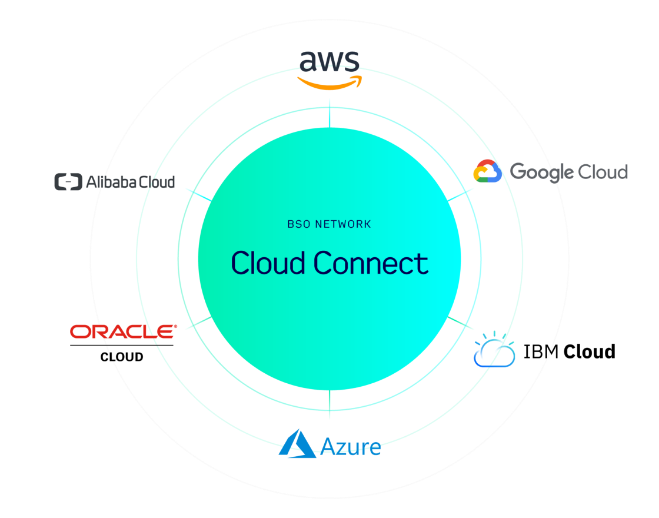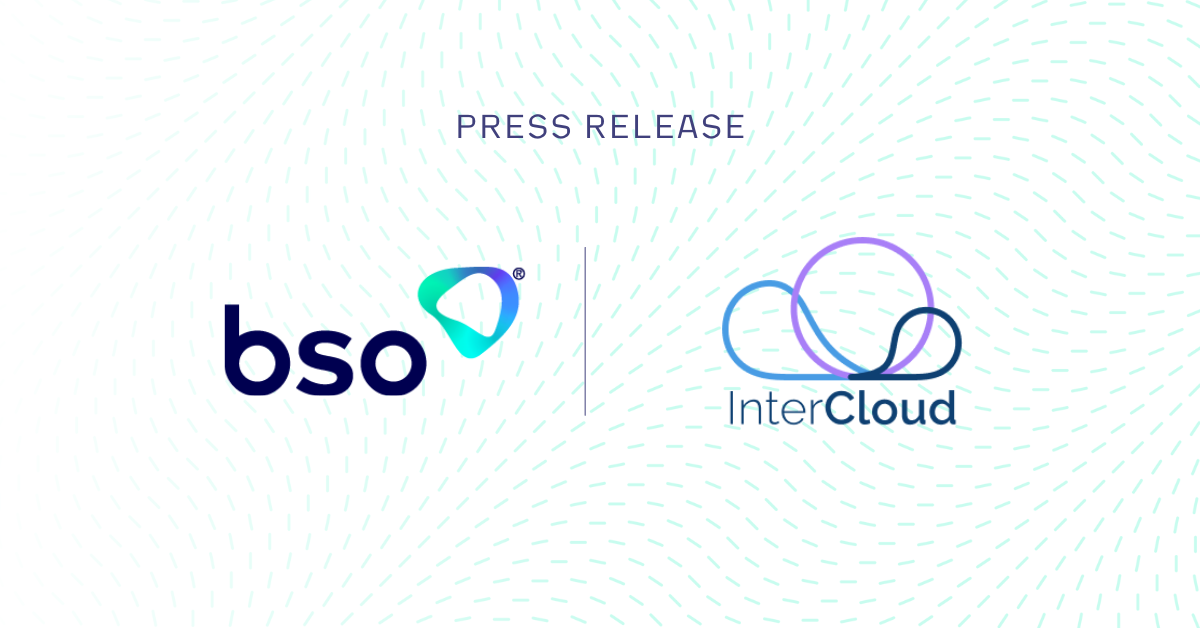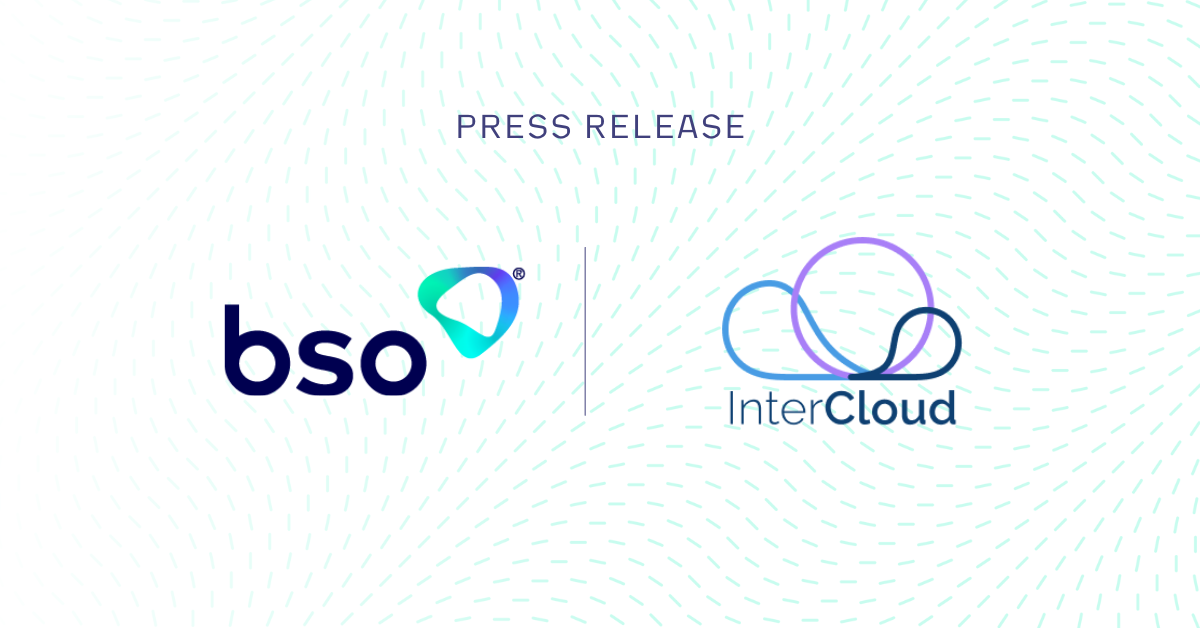PRODUCTS
Cloud-to-cloud_
Cloud Data Exchange_
Unleash a cloud connectivity service that provides the performance, security, pricing and diversity to support even the most complex workloads.
OUR SERVICE
What is cloud-to-cloud?
Cloud-to-cloud is the most secure, dependable way to connect your cloud resources to each other. BSO Cloud-to-cloud provides a dedicated path between two cloud regions, whether from the same provider in different markets or two separate cloud providers in the same market.
Delivered across our 240 PoP global network backbone that includes over 40 active cloud on-ramps with AWS, Azure, Google, IBM, Oracle and Alibaba, our list is constantly growing.
Virtual routers built with Juniper routing technology across our network ensure your traffic takes the most direct path possible. Cloud-to-cloud supports 50Mbps to 10Gbps connections and you can prioritise latency, diversity or value.

Key benefits_
Data path optimisation
No hairpinning traffic through your on-prem or data centre infrastructure.
Enhanced security
Traffic is completely private and isolated.
Reduced costs
Avoid higher internet gateway and data egress fees.
OUR DIFFERENCE
Why BSO for Cloud-to-cloud?
Design leadership
We live and breathe cloud, ensuring you receive the best cloud interconnection strategy for your needs.
Always investing
Continued investment in our network ensures we always offer the right speeds and redundancy for what customers require.
Utterly customisable
No one-size-fits-all here. We have packages for high-availability, low latency, and high-value designs, and can build fully bespoke solutions.
Availability_
Cloud-to-cloud is available across all active BSO cloud on-ramps.

Active cloud on-ramps_
PRODUCT SHEET
BSO’s Cloud-to-cloud product sheet_
WHAT OUR CLIENTS SAY

“We engaged BSO because of its international reach, reputation for ultra low latency connectivity, and experience in highly regulated financial markets. These qualities have proven true; however, it is BSO’s pace and flexibility that have stood out to us again and again.”
Thomas Schmeling Chief Executive Officer at CryptoStruct
JOIN OUR NETWORK
Not on-net with BSO?
Accessing BSO’s network is as easy as cross-connecting to us in your existing data centre. We have great relationships with regional carriers around the world if you aren’t present in where we are. For more information on our network, head to our network page.
Get in touch to connect your clouds with Cloud-to-cloud
FAQs
What is low-latency cloud-to-cloud connectivity?
Low-latency cloud-to-cloud connectivity refers to the high-speed and minimal-delay communication between different cloud-based services or platforms. It enables rapid data exchange and interaction between cloud components, crucial for real-time applications and seamless integration.
How does low-latency cloud-to-cloud connectivity work?
Low-Latency Cloud-to-Cloud Connectivity works by minimising the delay, or latency, in data transmission, ensuring that data travels quickly and efficiently between cloud components.
It relies on a combination of technologies and strategies to minimise data transfer delays between cloud services. It leverages high-speed networks, edge computing, CDNs, QoS mechanisms, optimised routing, redundancy, and stringent security measures to enable rapid data exchange and real-time interactions. This capability is especially valuable for applications in various industries, including finance, healthcare, gaming, and IoT, where low-latency is a critical factor for success.
What are the benefits of low-latency cloud-to-cloud connectivity?
Low-latency cloud-to-cloud connectivity offers a multitude of benefits that have a profound impact on various aspects of businesses and user experiences. Here are the key advantages:
Data path optimisation: By eliminating the need to route traffic through on-premises or data centre infrastructure, low-latency connectivity optimises data paths. This means data flows directly between cloud services, reducing latency and ensuring efficient data exchange.
Enhanced security: Low-latency connectivity ensures that traffic remains private and isolated. Data is shielded from potential threats associated with public internet traffic, enhancing overall security.
Reduced costs: Businesses can avoid higher internet gateway and data egress fees by optimising data paths. This reduction in data transfer costs contributes to cost savings.
Enhanced user experience: Low-latency is a cornerstone of a smoother and more responsive user experience. Applications respond quickly, delivering data in real-time, making applications more efficient for users.
Real-time interactions: Applications relying on real-time interactions, such as online gaming and video conferencing, greatly benefit from low-latency. It reduces delays, lag, and buffering, resulting in more seamless and immersive user experience.
Improved productivity: Low-latency connectivity enables higher levels of productivity. Employees can collaborate in real-time, share data, and access cloud-based tools without frustrating delays. This is particularly valuable for remote work setups and collaborative projects.
Competitive advantage: With low-latency connectivity, businesses gain a competitive edge. They can deliver services and content faster than competitors, a crucial advantage in industries like e-commerce, where faster load times lead to higher conversion rates.
Improved customer satisfaction: Businesses offering low-latency services, such as e-commerce platforms, streaming services, and online gaming, tend to have higher customer satisfaction rates. Improved performance and reliability contribute to a more satisfying user experience.
How does low-latency cloud-to-cloud connectivity improve network performance?
Low-latency cloud-to-cloud connectivity plays a crucial role in improving network performance for various reasons. It involves establishing fast and reliable communication between different cloud services or data centres. Here's how low-latency cloud-to-cloud connectivity enhances network performance:
Minimised latency: Reduced delay in data transmission between cloud services or data centres, resulting in faster communication and data transfer.
Real-time applications: Supports applications requiring instantaneous data processing, such as online gaming, video conferencing, and crypto trading platforms.
Stability: Increases network reliability by minimising disruptions and packet loss, ensuring consistent data flow.
Optimised load balancing: Efficiently distributes workloads among cloud resources, maximising resource utilisation.
Edge computing: Facilitates responsive edge computing by enabling rapid data exchange between edge devices and cloud processing resources.
Scalability: Supports seamless network expansion as organisations grow, maintaining consistent performance.
Cost efficiency: Reduces operational costs by optimising data transfer, minimising wasted bandwidth, and enhancing energy efficiency.
What are the compatibility requirements for low-latency cloud-to-cloud connectivity?
Compatibility requirements for low-latency cloud-to-cloud connectivity include:
1. Network protocols: Ensuring compatibility between the network protocols used by cloud services to enable seamless communication.
2. Latency-aware infrastructure: Choosing cloud providers and data centres equipped to minimise latency through high-speed connections and edge computing capabilities.
3. Consistent API versions: Verifying that APIs used are compatible in terms of versioning and functionality for effective data exchange.
4. Security protocols: Aligning security measures, such as VPNs and encryption standards, to protect data during transmission.
5. Location awareness: Selecting geographically close cloud regions or data centres to reduce physical distance and latency.
6. Bandwidth capacity: Ensuring sufficient bandwidth to handle data traffic between cloud services without congestion.
7. Quality of service (QoS): Implementing QoS mechanisms to prioritise traffic for low-latency delivery of critical applications.
8. Monitoring and optimisation tools: Employing network monitoring and optimisation tools to continuously assess and fine-tune latency-related performance.
9. Vendor compatibility: Verifying compatibility between cloud service providers and their services to enable seamless integration.
10. Scalability: Confirming that the cloud infrastructure can scale to accommodate increased traffic and data volume without introducing latency issues.
11. Redundancy and failover: Implementing redundancy and failover solutions to ensure network resilience in case of disruptions or failures.
12. Network routing: Optimising network routing configurations to reduce hops and facilitate efficient traffic flow between cloud locations.
13. Interconnect options: Exploring dedicated interconnect solutions or direct peering agreements between cloud providers for enhanced low-latency connectivity.
14. Compliance and regulations: Adhering to industry regulations and data sovereignty requirements that may impact cloud-to-cloud connectivity choices.
15. Application compatibility: Ensuring that applications and services hosted in different clouds are designed to work together seamlessly, and handle data with minimal latency.
Can low-latency cloud-to-cloud connectivity support multiple cloud service providers?
Yes, low-latency cloud-to-cloud connectivity, such as BSO Cloud-to-cloud, can indeed support multiple cloud service providers by offering a dedicated path between two cloud regions. This applies whether the regions are from the same cloud provider in different markets or involve two separate cloud providers in the same market, ensuring efficient data exchange and network performance.
How secure is low-latency cloud-to-cloud connectivity?
BSO's low-latency cloud-to-cloud connectivity is designed with a strong focus on security. It incorporates robust security measures, including encryption, access controls, and network monitoring, to ensure the confidentiality and integrity of data during transmission. BSO's commitment to security standards and best practices helps maintain a highly secure environment for cloud-to-cloud connectivity, safeguarding sensitive information and ensuring data privacy.
What are the key features of low-latency cloud-to-cloud connectivity?
The key features of low-latency cloud-to-cloud connectivity include:
- Reduced data transfer times
- Enhanced real-time application support
- Improved network reliability
- Efficient load balancing
- Seamless scalability
- Edge computing support
These features collectively enable rapid data exchange and optimised performance between cloud services or data centres
Can low-latency cloud-to-cloud connectivity support hybrid cloud environments?
Yes, low-latency cloud-to-cloud connectivity can support hybrid cloud environments, enabling efficient communication between public and private cloud resources as well as on-premises infrastructure. This connectivity helps organisations seamlessly integrate and manage resources across diverse cloud environments while maintaining low-latency data exchange.





/Revolutionising-Connectivity%20BSOs-Tailored-Cloud-Solution-for-CryptoStruct-GmbH.png?width=1050&height=550&name=Revolutionising-Connectivity%20BSOs-Tailored-Cloud-Solution-for-CryptoStruct-GmbH.png)
/6%20Cloud%20Best%20Practices%20for%20Financial%20Technology%20Companies.jpg?width=1200&height=600&name=6%20Cloud%20Best%20Practices%20for%20Financial%20Technology%20Companies.jpg)









